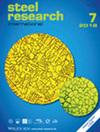中心焦比对高炉内部状态的影响
IF 1.9
3区 材料科学
Q2 METALLURGY & METALLURGICAL ENGINEERING
引用次数: 0
摘要
中央装焦(CCC)是高炉(BF)广泛采用的一种炉料分配方法。调整中心焦比会改变炉料温度场,影响高炉的平稳运行。本研究提出了一个物理和数学耦合模型,其中包括两个 5500 立方米高炉中的颗粒运动、煤气流动以及炉料和煤气之间的热传递。高炉 A(BFA)和高炉 B(BFB)的中心焦比分别为 15%和 20%。高炉A和高炉B的内聚区的根部位置分别位于烟囱和烟囱区的下部。在 BF 的中心区域,BFB 的气体流速、气体温度和负担温度都较高。在 BF 的边缘区域,BFA 的气体流速、气体温度和负载温度较高。实际顶部气体温度和气体压力验证了所提模型的准确性。该模型研究了中心焦比对内聚区位置、煤气流速、煤气温度和炉料温度的影响,为研究炉料分布矩阵对 BF 内部状态的影响提供了一种经济有效的方法。本文章由计算机程序翻译,如有差异,请以英文原文为准。
Influence of Central Coke Ratio on the Internal State of Blast Furnace
Central coke charging (CCC) is a widely used burden distribution method for blast furnaces (BFs). Adjusting the central coke ratio can change the burden temperature field and affect the smooth operation of BF. This study presents a coupled physical and mathematical model, incorporating particle motion, gas flow, and heat transfer between the burden and gas in two 5500 m3 BFs. The central coke ratios of the blast furnace A (BFA) and blast furnace B (BFB) is 15% and 20%, respectively. The root positions of the cohesive zone in the BFA and BFB are in the lower part of the stack and bosh zones, respectively. In the central area of the BF, the gas flow rate, gas temperature, and burden temperature of the BFB are higher. In the edge area of the BF, the gas flow rate, gas temperature, and burden temperature of the BFA are higher. The actual top gas temperature and gas pressure verify the accuracy of the proposed model. This model investigates the influence of the central coke ratio on the position of the cohesive zone, gas flow rate, gas temperature, and burden temperature, providing a cost‐effective method for studying the effect of the burden distribution matrix on the internal state of the BF.
求助全文
通过发布文献求助,成功后即可免费获取论文全文。
去求助
来源期刊

steel research international
工程技术-冶金工程
CiteScore
3.30
自引率
18.20%
发文量
319
审稿时长
1.9 months
期刊介绍:
steel research international is a journal providing a forum for the publication of high-quality manuscripts in areas ranging from process metallurgy and metal forming to materials engineering as well as process control and testing. The emphasis is on steel and on materials involved in steelmaking and the processing of steel, such as refractories and slags.
steel research international welcomes manuscripts describing basic scientific research as well as industrial research. The journal received a further increased, record-high Impact Factor of 1.522 (2018 Journal Impact Factor, Journal Citation Reports (Clarivate Analytics, 2019)).
The journal was formerly well known as "Archiv für das Eisenhüttenwesen" and "steel research"; with effect from January 1, 2006, the former "Scandinavian Journal of Metallurgy" merged with Steel Research International.
Hot Topics:
-Steels for Automotive Applications
-High-strength Steels
-Sustainable steelmaking
-Interstitially Alloyed Steels
-Electromagnetic Processing of Metals
-High Speed Forming
 求助内容:
求助内容: 应助结果提醒方式:
应助结果提醒方式:


